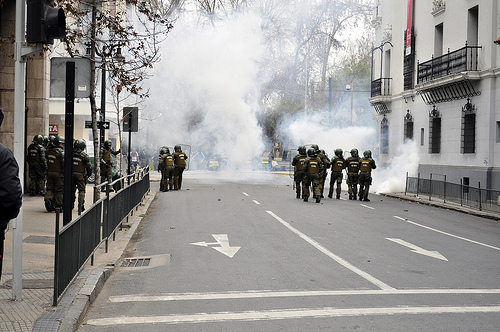Hundreds of Chilean students, fighting to overhaul their education system, clashed with an intensified police force as they protested without permission on Thursday 4 August, 2011, through the center of capital Santiago.
The Student Confederation of Chile (CONFECH) called students across Chile to protest in April, a month after school began. Students were fed up with the growing privatization trend in Chile that began under Augusto Pinochet's dictatorship in the 1980s.
So far, every protest for education reform has ended with marchers drenched by water cannon jets and clouds of tear gas. Thursday morning’s protest was no different, except some politicians said, this time the violence against students crossed the line.

Police use a "guanaco" water jet to disperse students. Image by Flickr user FabsY_ (CC BY-NC-SA 2.0).
Over 1,000 officers driving armored vehicles, forging ahead on foot in bullet-proof “Carabineros” (police) uniforms, and riding teams of horses herded the students away from the presidential palace. Metal gates sealed off several metro stations.
The protest sky-rocketed to the top of the city's trending topics on Twitter as students vented their growing frustrations using hashtags like #4deagosto, #laalamedaesnuestra and #camilasomostodos.
Online news site El Dínamo put together two Storify posts with citizen reactions and reports, one focusing on events taking place in Santiago [es], and another one on protests across the country [es].
Eder Rivas (@ederivas), tweeted at 1:08 p.m.:
En las protestas hay toda clase de animales: guanacos y carabineros. Sólo faltan militares y armamos un zoológico.
Students often compare “guanacos”, an infamous spitting Chilean camel, to the police vehicle that fires water from its roof.
Many demonstrators remained calm, but some – covered by hooded sweatshirts, gloves and masks – pelted police vehicles with rocks. Two officers were wounded. Police detained 235 of the 800 or so protesting students.
Students actually requested permission to have this two-part march on Thursday starting at 10:30 am for high school students. CONFECH organized a second march at 6:30 pm. But both parties were told to disband by the authorities.
Interior Minister Rodrigo Hinzpeter said on Wednesday that he won’t authorize any new student marches on the street leading to the presidential office, called Alameda. He cited millions of dollars in damages, business-owner complaints, and lost class-time as the reasons behind his decision.
Unfazed by Hinzpeter’s disapproval, students exercised their constitutional right to protest. Chile's Constitution in Article 19, No. 13, guarantees the “right to peaceful assembly without prior permission and without arms.”
A contradictory regulation, issued in 1983 during Augusto Pinochet’s dictatorship, allows the dissolution of demonstrations that do not have the appropriate permission from authorities, i.e. Hinzpeter’s approval. The rule also gives authorities the power to dissolve a demonstration. The Equality Institute took a closer look at the conflict and deemed it unconstitutional [es].
Nevertheless, Hinzpeter still envoked the decree's power to ban the students from protesting.
Camila Vallejo (@camila_vallejo), leader of CONFECH, tweeted:
Lo que hoy pasa en nuestro pais, desnuda a la derecha en su verdadera forma de gobernar, nosotros no tenemos miedo, ellos si.
Hinzpeter’s decision proved to be a political misstep for the minister. Immediately following 10:30 am demonstration, a group of deputies and senators called for his resignation due to him authorizing a “brutal crackdown on students.” [es]
On Monday, President Sebastián Piñera presented a series of 21 reforms that would install new government agencies to handle educational concerns. His plan called for an increase in educational funding to help pay teachers and take care of unpaid student loans. It would also offer more scholarships to universities.
CONFECH said they’ll respond to the president’s plan on Friday. If the escalating violence and continued demonstrations in Santiago and across Chile today are an indication, Piñera’s plan hasn’t placated the protesters.
Sergio Canales, (@sergiocanalesv), tweeted:
Esto hace rato dejó de ser tema de derecha o izquierda, es gente normal que quiere las cosas más justas #4deagosto.
Sentidos Comunes posted live streaming video of the protests, as did @VotaInteligente. Furthermore, students inside the Universidad de Concepción in southern Chile streamed throughout the day via Twitcam.
A ‘cacerolazo‘ was planned for Thursday night, as Global Voices author Felipe Cordero (@felipe_cordero) reports on Twitter:
Impressive number of people banging pots throughout Santiago. It hasn't stopped. This is not a struggle of a minority of students #4deagosto
#cacerolazo became a worldwide trending topic on the night of Thursday, August 4.
Katie Manning reports for www.MiVoz.cl, which publishes 14 citizen journalism news sites across the provinces of Chile. More detail about the student protests sweeping through Chile is online at www.elnortero.cl.








11 comments
IM FROM CHILE LIVING IN NYC AND JUST FIND OUT VIA TWITCAM LIVE ON THE STREETS OF SANTIAGO THAT 3 PERSONS ARE DEAD AND THAT THERES A GROUP OF STUDENTS IN HUNGER STRIKE FOR 20 DAYS NOW.
THINGS ARE GETTING VERY SERIOUS IN CHILE AND THE CHILEAN PRESS IS NOT PAYING ENOUGTH ATTENCION TO THIS. PLEASE SPREAD THE WORD
Matías,
Fortunately, there is not dead people, but the repression is excessive and against the human rights.
Help spread the massive repression of the Chilean people.